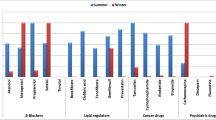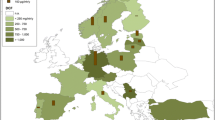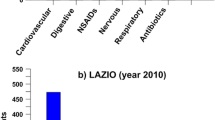Abstract
Beta-agonist pharmaceuticals are widely used in humans and livestock for disease treatment, legal or illegal growth promotion in food animals, bodybuilding, weight loss, and sports doping. The occurrence of beta-agonists in wastewater treatment plants and their subsequent environmental impacts require greater attention. This study determined the levels of 12 beta-agonists in a wastewater treatment plant and evaluated their ecotoxicological risks as well as consumption levels and risks to human health. Among the 12 selected beta-agonists, all were detected in wastewater and 11 in sludge. In most cases, the concentrations of beta-agonists were higher in spring than in summer. Their total average daily mass loads per capita in the influent and effluent were 1.35 μg/d/p and 2.11 μg/d/p, respectively. The overall removal efficiencies of individual beta-agonists ranged from -295.3 to 71.2%. Ecotoxicological risk assessment revealed a low risk to daphnid and green algae from the levels of fenoterol and the mixture of 12 selected beta-agonists in the effluent. The daily consumption levels of individual beta-agonists per capita were 0.028–1.200 μg/d/p. Regular monitoring of beta-agonists in municipal sewage systems and their risk assessment based on toxicological data are urgently required in the future.




Similar content being viewed by others
Availability of data and materials
All data generated or analyzed during this study are included in this manuscript and its supplementary information files.
References
Al-Rifai, J. H., Khabbaz, H., & Schafer, A. I. (2011). Removal of pharmaceuticals and endocrine disrupting compounds in a water recycling process using reverse osmosis systems. Separation and Purification Technology, 77(1), 60–67. https://doi.org/10.1016/j.seppur.2010.11.020
Al Aukidy, M., Verlicchi, P., Jelic, A., Petrovic, M., & Barcelo, D. (2012). Monitoring release of pharmaceutical compounds: Occurrence and environmental risk assessment of two WWTP effluents and their receiving bodies in the Po Valley, Italy. Science of the Total Environment, 438, 15–25. https://doi.org/10.1016/j.scitotenv.2012.08.061
Anderson, W., Brinton, J., Kaye, L., Hoch, H., Barrett, M., & Van Sickle, D., et al. (2018). Real-life patterns of short-acting beta-agonist use in persistent asthmatics vary by age, time of day, and season. Journal of Allergy and Clinical Immunology, 141(2), AB61-AB61. https://doi.org/10.1016/j.jaci.2017.12.197
Anh, H. Q., Le, T. P. Q., Da Le, N., Lu, X. X., Duong, T. T., Garnier, J., et al. (2021). Antibiotics in surface water of East and Southeast Asian countries: A focused review on contamination status, pollution sources, potential risks, and future perspectives. Science of the Total Environment, 764, 16. https://doi.org/10.1016/j.scitotenv.2020.142865
Bernard, N., Cuisinaud, G., Pozet, N., Zech, P. Y., & Sassard, J. (1985). Pharmacokinetics of penbutolol and its metabolites in renal-insufficiency. European Journal of Clinical Pharmacology, 29(2), 215–219. https://doi.org/10.1007/bf00547425
Bijlsma, L., Pitarch, E., Fonseca, E., Ibanez, M., Botero, A. M., Claros, J., et al. (2021). Investigation of pharmaceuticals in a conventional wastewater treatment plant: Removal efficiency, seasonal variation and impact of a nearby hospital. Journal of Environmental Chemical Engineering, 9(4), 13. https://doi.org/10.1016/j.jece.2021.105548
Billington, C. K., Penn, R. B., & Hall, I. P. (2017). beta(2) Agonists. In C.P. Page & P.J. Barnes (Eds.), Pharmacology and Therapeutics of Asthma and COPD (Vol. 237, pp. 23–40): Springer-Verlag Berlin, Heidelberger Platz 3, D-14197 Berlin, Germany.
Botero-Coy, A. M., Martinez-Pachon, D., Boix, C., Rincon, R. J., Castillo, N., Arias-Marin, L. P., et al. (2018). An investigation into the occurrence and removal of pharmaceuticals in Colombian wastewater. Science of the Total Environment, 642, 842–853. https://doi.org/10.1016/j.scitotenv.2018.06.088
Brown, D., Snow, D., Hunt, G. A., & Bartelt-Hunt, S. L. (2015). Persistence of Pharmaceuticals in Effluent-Dominated Surface Waters. Journal of Environmental Quality, 44(1), 299–304. https://doi.org/10.2134/jeq2014.08.0334
Cheng, L. M., Hao, G. T., Chen, X. Y., Zhang, Y. F., Zhang, Y. Y., & Dong, R. H., et al. (2016). Quantification of tulobuterol, a selective beta2 adrenergic agonist, in human plasma by liquid chromatography-tandem quadrupole mass spectrometry. Journal of Chinese Pharmaceutical Sciences, 25(7), 526–534. https://kns.cnki.net/kcms/detail/11.2863.r.20160709.1617.012.html
Couto, C. F., Lange, L. C., & Amaral, M. C. S. (2019). Occurrence, fate and removal of pharmaceutically active compounds (PhACs) in water and wastewater treatment plants-A review. Journal of Water Process Engineering, 32, 17. https://doi.org/10.1016/j.jwpe.2019.100927
Du, H. J., Chu, Y. X., Yang, H., Zhao, K., Li, J. G., She, P., et al. (2016). Sensitive and specific detection of a new beta-agonist brombuterol in tissue and feed samples by a competitive polyclonal antibody based ELISA. Analytical Methods, 8(17), 3578–3586. https://doi.org/10.1039/c6ay00079g
El Sony, A. (2017). Asthma: The increasing, unchecked epidemic. International Journal of Tuberculosis and Lung Disease, 21(10), 1074–1074. https://doi.org/10.5588/ijtld.17.0575
EMEA. (2006). Guideline on the Environmental Risk Assessment of Medicinal Products for Human Use.
Fattore, E., Davoli, E., Castiglioni, S., Bosetti, C., Depaolini, A. R., Marzona, I., et al. (2016). Wastewater-based epidemiological evaluation of the effect of air pollution on short-acting beta-agonist consumption for acute asthma treatment. Environmental Research, 150, 106–111. https://doi.org/10.1016/j.envres.2016.05.051
Feng, H. R., Zhang, C., & Ying, S. M. (2018). Classical and Emerging Therapies against Chronic Obstructive Pulmonary Disease. Chinese Medical Journal, 131(16), 1894–1897. https://doi.org/10.4103/0366-6999.238133
Fragkaki, A. G., Georgakopoulos, C., Sterk, S., & Nielen, M. W. F. (2013). Sports doping: Emerging designer and therapeutic beta(2)-agonists. Clinica Chimica Acta, 425, 242–258. https://doi.org/10.1016/j.cca.2013.07.031
Garcia, J., Garcia-Galan, M. J., Day, J. W., Boopathy, R., White, J. R., Wallace, S., et al. (2020). A review of emerging organic contaminants (EOCs), antibiotic resistant bacteria (ARB), and antibiotic resistance genes (ARGs) in the environment: Increasing removal with wetlands and reducing environmental impacts. Bioresource Technology, 307, 10. https://doi.org/10.1016/j.biortech.2020.123228
Han, S., Wang, Z. L., Huang, H. M., Wang, T., Zhou, Z. L., Bai, Y., et al. (2022). Estimating antibiotics use in major cities in China through wastewater-based epidemiology. Science of the Total Environment, 826, 8. https://doi.org/10.1016/j.scitotenv.2022.154116
Herklotz, P. A., Gurung, P., Heuvel, B. V., & Kinney, C. A. (2010). Uptake of human pharmaceuticals by plants grown under hydroponic conditions. Chemosphere, 78(11), 1416–1421. https://doi.org/10.1016/j.chemosphere.2009.12.048
Hernando, M. D., Mezcua, M., Fernandez-Alba, A. R., & Barcelo, D. (2006). Environmental risk assessment of pharmaceutical residues in wastewater effluents, surface waters and sediments. Talanta, 69(2), 334–342. https://doi.org/10.1016/j.talanta.2005.09.037
Holling, C. S., Bailey, J. L., Heuvel, B. V., & Kinney, C. A. (2012). Uptake of human pharmaceuticals and personal care products by cabbage (Brassica campestris) from fortified and biosolids-amended soils. Journal of Environmental Monitoring, 14(11), 3029–3036. https://doi.org/10.1039/c2em30456b
Hozawa, S., Haruta, Y., Terada, M., & Yamakido, M. (2009). Effects of the Addition of Beta2-agonist Tulobuterol Patches to Inhaled Corticosteroid in Patients with Asthma. Allergology International, 58(4), 509–518. https://doi.org/10.2332/allergolint.08-OA-0060
Hu, J., Zhou, J., Zhou, S. Q., Wu, P., & Tsang, Y. F. (2018). Occurrence and fate of antibiotics in a wastewater treatment plant and their biological effects on receiving waters in Guizhou. Process Safety and Environmental Protection, 113, 483–490. https://doi.org/10.1016/j.psep.2017.12.003
Huang, K. W., Yang, T., Xu, J. Y., Yang, L., Zhao, J. P., Zhang, X. Y., et al. (2019). Prevalence, risk factors, and management of asthma in China: A national cross-sectional study. Lancet, 394(10196), 407–418. https://doi.org/10.1016/s0140-6736(19)31147-x
Huang, W., Guo, E. H., Li, J. G., & Deng, A. P. (2021). Quantitative and ultrasensitive detection of brombuterol by a surface-enhanced Raman scattering (SERS)-based lateral flow immunochromatographic assay (FLIA) using Ag-MBA@Au-Ab as an immunoprobe. The Analyst, 146(1), 296–304. https://doi.org/10.1039/d0an01949f
Jack, D.B., Gaarn, H.B., Johansson, S., Marita, L., Ms, J., & Musset, C., et al. (2002). Technical guidance document on risk assessment. Part 1. Part 2.
Jelic, A., Gros, M., Ginebreda, A., Cespedes-Sanchez, R., Ventura, F., Petrovic, M., et al. (2011). Occurrence, partition and removal of pharmaceuticals in sewage water and sludge during wastewater treatment. Water Research, 45(3), 1165–1176. https://doi.org/10.1016/j.watres.2010.11.010
Jiang, X., Pan, W. Y., Xiong, Z. L., Zhang, Y. X., & Zhao, L. S. (2021). Facile synthesis of layer-by-layer decorated graphene oxide based magnetic nanocomposites for beta-agonists/dyes adsorption removal and bacterial inactivation in wastewater. Journal of Alloys and Compounds, 870, 12. https://doi.org/10.1016/j.jallcom.2021.159414
Jones, O. A. H., Voulvoulis, N., & Lester, J. N. (2007). The occurrence and removal of selected pharmaceutical compounds in a sewage treatment works utilising activated sludge treatment. Environmental Pollution, 145(3), 738–744. https://doi.org/10.1016/j.envpol.2005.08.077
Lee, H. B., Sarafin, K., & Peart, T. E. (2007). Determination of β-blockers and β2-agonists in sewage by solid-phase extraction and liquid chromatography–tandem mass spectrometry. Journal of Chromatography A, 1148(2), 158–167.
Li, C., Wu, Y. L., Yang, T., Zhang, Y., & Huang-Fu, W. G. (2010). Simultaneous determination of clenbuterol, salbutamol and ractopamine in milk by reversed-phase liquid chromatography tandem mass spectrometry with isotope dilution. Journal of Chromatography A, 1217(50), 7873–7877. https://doi.org/10.1016/j.chroma.2010.10.055
Lin, A. Y. C., Yu, T. H., & Lin, C. F. (2008). Pharmaceutical contamination in residential, industrial, and agricultural waste streams: Risk to aqueous environments in Taiwan. Chemosphere, 74(1), 131–141. https://doi.org/10.1016/j.chemosphere.2008.08.027
Liu, H. Q., Lam, J. C. W., Li, W. W., Yu, H. Q., & Lam, P. K. S. (2017). Spatial distribution and removal performance of pharmaceuticals in municipal wastewater treatment plants in China. Science of the Total Environment, 586, 1162–1169. https://doi.org/10.1016/j.scitotenv.2017.02.107
Monsalvo, V. M., McDonald, J. A., Khan, S. J., & Le-Clech, P. (2014). Removal of trace organics by anaerobic membrane bioreactors. Water Research, 49, 103–112. https://doi.org/10.1016/j.watres.2013.11.026
Papi, A., Brightling, C., Pedersen, S. E., & Reddel, H. K. (2018). Asthma. Lancet, 391(10122), 783–800. https://doi.org/10.1016/s0140-6736(17)33311-1
Peng, T., Zhang, F. S., Yang, W. C., Li, D. X., Chen, Y., Xiong, Y. H., et al. (2014). Lateral-Flow Assay for Rapid Quantitative Detection of Clorprenaline Residue in Swine Urine. Journal of Food Protection, 77(10), 1824–1829. https://doi.org/10.4315/0362-028x.Jfp-14-103
Pereira, A., Silva, L., Laranjeiro, C., Lino, C., & Pena, A. (2020). Selected pharmaceuticals in different aquatic compartments: Part I-Source. Fate and Occurrence. Molecules, 25(5), 33. https://doi.org/10.3390/molecules25051026
Radjenovic, J., Petrovic, M., & Barcelo, D. (2009). Fate and distribution of pharmaceuticals in wastewater and sewage sludge of the conventional activated sludge (CAS) and advanced membrane bioreactor (MBR) treatment. Water Research, 43(3), 831–841. https://doi.org/10.1016/j.watres.2008.11.043
Sachett, A., Bevilaqua, F., Chitolina, R., Garbinato, C., Gasparetto, H., Dal Magro, J., et al. (2018). Ractopamine hydrochloride induces behavioral alterations and oxidative status imbalance in zebrafish. Journal of Toxicology and Environmental Health-Part a-Current Issues, 81(7), 194–201. https://doi.org/10.1080/15287394.2018.1434848
Salem, A. A., Wasfi, I. A., & Al-Nassibi, S. S. (2012). Trace determination of beta-blockers and beta(2)-agonists in distilled and waste-waters using liquid chromatography-tandem mass spectrometry and solid-phase extraction. Journal of Chromatography B-Analytical Technologies in the Biomedical and Life Sciences, 908, 27–38. https://doi.org/10.1016/j.jchromb.2012.09.026
Silverman, R. A., Stevenson, L., & Hastings, H. M. (2003). Age-related seasonal patterns of emergency department visits for acute asthma in an urban environment. Annals of Emergency Medicine, 42(4), 577–586. https://doi.org/10.1067/s0196-0644(03)00410-4
Sun, L. W., Wang, S. S., Lin, X., Tan, H. N., & Fu, Z. W. (2016). Early Life Exposure to Ractopamine Causes Endocrine-Disrupting Effects in Japanese Medaka (Oryzias latipes). Bulletin of Environmental Contamination and Toxicology, 96(2), 150–155. https://doi.org/10.1007/s00128-015-1659-5
Ternes, T. A. (1998). Occurrence of drugs in German sewage treatment plants and rivers. Water Research, 32(11), 3245–3260. https://doi.org/10.1016/s0043-1354(98)00099-2
Tsui, M. M. P., Leung, H. W., Lam, P. K. S., & Murphy, M. B. (2014). Seasonal occurrence, removal efficiencies and preliminary risk assessment of multiple classes of organic UV filters in wastewater treatment plants. Water Research, 53, 58–67. https://doi.org/10.1016/j.watres.2014.01.014
Turi, K. N., Gebretsadik, T., Lee, R. L., Hartert, T. V., Evans, A. M., Stone, C., et al. (2018). Seasonal patterns of Asthma medication fills among diverse populations of the United States. Journal of Asthma, 55(7), 764–770. https://doi.org/10.1080/02770903.2017.1362426
Ungemach, F. R. (2004). Ractopamine (WHO Food Additives Series 53). IPCS INCHEM.
Verlicchi, P., Al Aukidy, M., & Zambello, E. (2012). Occurrence of pharmaceutical compounds in urban wastewater: Removal, mass load and environmental risk after a secondary treatment-A review. Science of the Total Environment, 429, 123–155. https://doi.org/10.1016/j.scitotenv.2012.04.028
Wang, C. J., Liu, H. J., Chou, T. C., Lin, C. C., Pan, W. H., Chen, P. C., et al. (2022). Simultaneous determination of eight beta-adrenergic agonists in human urine by an isotope dilution-online clean-up system coupled with liquid chromatography-tandem mass spectrometry. Chemosphere, 301, 9. https://doi.org/10.1016/j.chemosphere.2022.134778
Wang, J. L., & Wang, S. Z. (2016). Removal of pharmaceuticals and personal care products (PPCPs) from wastewater: A review. Journal of Environmental Management, 182, 620–640. https://doi.org/10.1016/j.jenvman.2016.07.049
Xu, C. J., Gao, H. C., Pan, N. Z., Jiang, M. M., Huang, Y., Zhu, K. T., et al. (2019). Clenbuterol, salbutamol, and ractopamine in fresh meat products in Jilin province. China. International Journal of Food Properties, 22(1), 1183–1194. https://doi.org/10.1080/10942912.2019.1634100
Xue, W. C., Wu, C. Y., Xiao, K., Huang, X., Zhou, H. D., Tsuno, H., et al. (2010). Elimination and fate of selected micro-organic pollutants in a full-scale anaerobic/anoxic/aerobic process combined with membrane bioreactor for municipal wastewater reclamation. Water Research, 44(20), 5999–6010. https://doi.org/10.1016/j.watres.2010.07.052
Yan, K. P., Zhang, H. Q., Hui, W. L., Zhu, H. L., Li, X. B., Zhong, F. Y., et al. (2016). Rapid screening of toxic salbutamol, ractopamine, and clenbuterol in pork sample by high-performance liquid chromatography-UV method. Journal of Food and Drug Analysis, 24(2), 277–283. https://doi.org/10.1016/j.jfda.2015.12.002
Yan, Q., Gao, X., Huang, L., Gan, X. M., Zhang, Y. X., Chen, Y. P., et al. (2014). Occurrence and fate of pharmaceutically active compounds in the largest municipal wastewater treatment plant in Southwest China: Mass balance analysis and consumption back-calculated model. Chemosphere, 99, 160–170. https://doi.org/10.1016/j.chemosphere.2013.10.062
Yu, T. H., Lin, A. Y. C., Wang, X. H., & Lin, C. F. (2011). Occurrence of beta-blockers and beta-agonists in hospital effluents and their receiving rivers in southern Taiwan. Desalination and Water Treatment, 32(1–3), 49–56. https://doi.org/10.5004/dwt.2011.2677
Yuan, S. F., Liu, Z. H., Huang, R. P., Yin, H., & Dang, Z. (2016). Levels of six antibiotics used in China estimated by means of wastewater-based epidemiology. Water Science and Technology, 73(4), 769–775. https://doi.org/10.2166/wst.2015.526
Yuge, T., Hase, T., Takayanagi, Y., Kamasuka, T., Amemiya, K., & Horiba, M. (1984). Pharmacokinetic studies of mabuterol, a new selective beta-2-stimulant .1. studies on the absorption, distribution and excretion in rats. Arzneimittel-Forschung/Drug Research, 34–2(11A), 1659–1667. Retrieved from <Go to ISI>://WOS:A1984TW81900007
Zhang, M., Fawcett, J. P., & Shaw, J. P. (2002). Stereoselective urinary excretion of formoterol and its glucuronide conjugate in human. British Journal of Clinical Pharmacology, 54(3), 246–250. https://doi.org/10.1046/j.1365-2125.2002.01641.x
Zhao, J. L., Ying, G. G., Liu, Y. S., Chen, F., Yang, J. F., Wang, L., et al. (2010). Occurrence and a screening-level risk assessment of human pharmaceuticals in the pearl river system South China. Environmental Toxicology and Chemistry, 29(6), 1377–1384. https://doi.org/10.1002/etc.161
Acknowledgements
The authors greatly acknowledge the Department of Environment and Health, School of Public Health, Cheeloo College of Medicine, Shandong University for providing the infrastructure facilities and support to conduct the experiments.
Funding
This study was supported by National Key Research and Development Program of China (2020YFC1806904-1).
Author information
Authors and Affiliations
Contributions
The study conception, supervision, funding acquisition, and project administration were performed by Xuewen Li. Material preparation, sample collection and laboratory analysis were performed by Kefang Li, Xiangwei Zhao, Huiyun Zou, and Ling Zhao. Data processing and analysis were performed by Hui Zhang. The first draft of the manuscript was written by Hui Zhang, and all authors commented on previous versions of the manuscript. All authors read and approved the final manuscript.
Corresponding author
Ethics declarations
Ethical responsibility
All authors have read, understood, and have complied as applicable with the statement on "Ethical responsibilities of Authors" as found in the Instructions for Authors.
Competing Interests
The authors declare that they have no known competing financial interests or personal relationships that could have appeared to influence the work reported in this paper.
Human and animal rights and informed consent
Not applicable. This study did not involve human participants and/or animals.
Additional information
Publisher's Note
Springer Nature remains neutral with regard to jurisdictional claims in published maps and institutional affiliations.
Supplementary Information
Below is the link to the electronic supplementary material.
Rights and permissions
Springer Nature or its licensor (e.g. a society or other partner) holds exclusive rights to this article under a publishing agreement with the author(s) or other rightsholder(s); author self-archiving of the accepted manuscript version of this article is solely governed by the terms of such publishing agreement and applicable law.
About this article
Cite this article
Zhang, H., Li, K., Zhao, X. et al. Occurrence, consumption level, fate and ecotoxicology risk of beta-agonist pharmaceuticals in a wastewater treatment plant in Eastern China. Environ Monit Assess 195, 481 (2023). https://doi.org/10.1007/s10661-023-11099-8
Received:
Accepted:
Published:
DOI: https://doi.org/10.1007/s10661-023-11099-8




